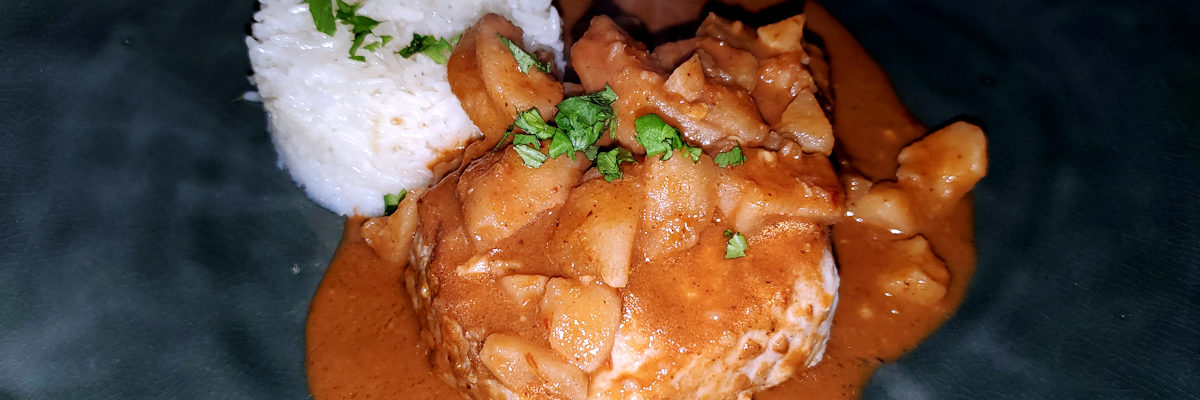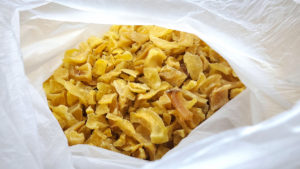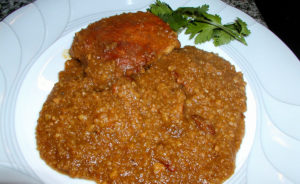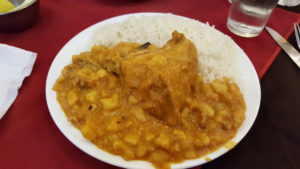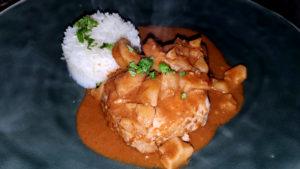Carapulcra means literally, “neat face”. So, why? Just poetic license is my bet. It’s actually just the Spanish-ization of the original Aymara name, qala phurk’a, which translates to “stew of hot stones”. In its most traditional form, it’s a stew made from rehydrated dry potatoes, either alpaca or llama meat, and a mix of spices – usually cinnamon, clove, and allspice, along with sweet wine, bitter chocolate, ground peanuts, and pork fat, with the cooking being done by dropping hot stones into the stew.
Carapulcra significa literalmente, “cara ordenada”. ¿Entonces por qué? Solo la licencia poética es mi apuesta. En realidad, es solo la española-ización del nombre aymara original, qala phurk’a, que se traduce como “guiso de piedras calientes”. En su forma más tradicional, es un guiso hecho de papas secas rehidratadas, carne de alpaca o de llama, y una mezcla de especias, generalmente canela, clavo de olor y pimienta de Jamaica, junto con vino dulce, chocolate amargo, maní molido y grasa de cerdo, con la cocción hecha arrojando piedras calientes en el guiso.
I’ve never really understood that sort of method of cooking, though it pops up now and again in various indigenous cuisines. I mean, if you’ve got a fire going, why not just cook the stew directly over the fire instead of heating stones and dropping them in the pot. I guess, if I think about it, maybe it’s a case of a pot that’s not fireproof? I’m just speculating.
Nunca he entendido realmente ese método de cocina, aunque aparece de vez en cuando en varias cocinas indígenas. Quiero decir, si tienes un fuego encendido, ¿por qué no solo cocinas el estofado directamente sobre el fuego en lugar de calentar piedras y dejarlas caer en la olla? Supongo que, si lo pienso, ¿tal vez se trata de una olla que no es incombustible? Solo estoy especulando.
One could, I suppose, make a case for the “hot stones” being the papas secas, or dried potatoes, but online research says that ain’t so.
Supongo que se podría argumentar que las “piedras calientes” son las papas secas, pero la investigación en línea dice que no es así.
Now, my first introduction to carapulcra was Henry making it, one of the only two times he took on making the Casa SaltShaker dinner… way back in November of 2006.
Ahora, mi primera introducción a Carapulcra fue Henry haciéndolo, una de los dos veces únicas que el elaboró la cena de Casa SaltShaker … en noviembre de 2006.
His version of it involved a bit of memory, a lot of texting with two of his sisters, who not only couldn’t agree on how to make it, but were texting with an aunt who lives up on the mountain in Calamarca, who had another opinion entirely, and a bit of making it up as he went along (I say, he says not). It involved grinding the dried potatoes up into a coarse, meal-like texture, toasting it, stewing it in beef stock, adding bits of marinated (white wine, vinegar, cumin) pork to it, along with peanuts and port, some salt, pepper, and then serving it with pieces of fried lechon, or suckling pig.
Su versión implicaba un poco de memoria, muchos mensajes de texto con dos de sus hermanas, quienes no solo no podían ponerse de acuerdo sobre cómo hacerlo, sino que estaban enviando mensajes de texto con una tía que vive en la montaña en Calamarca, que tenía otra opinión por completo, y un poco de invención (digo, dice que no). Implicó moler las papas secas en una textura gruesa, parecida a un cereal, tostarlas, guisarlas en caldo de res, agregarle trocitos de carne de cerdo marinada (vino blanco, vinagre, comino), junto con maní y oporto, un poco de sal pimienta, y luego servirlo con trozos de lechón frito.
Very different from the dish that we see when we see it in restaurants, which tend to look more like this. But the two together, and a lot of online research and experimenting led to an inspired version of the dish that comes out at Casa SaltShaker more like this:
Muy diferente que el plato que vemos cuando lo vemos en restaurantes, que tienden a parecerse más a esto. Pero los dos juntos, y mucha investigación y experimentación en línea condujeron a una versión inspirada del plato que sale en Casa SaltShaker más así:
A timbale of garlic rice. Pork loin that’s seared in a hot pan and then finished in the oven. The flavor all comes from the sauce – starting by rehydrating aji pankas and mirasols, the dried Peruvian red-brown and yellow chilies, then pureeing them with garlic, red onion, cumin, clove, cinnamon, and Chinese five-spice, and cocoa, and sauteing the mixture in a little butter. Then deglazing it with port, adding a dollop of peanut butter, and some bacon stock. Separately, I rehydrated the dried potatoes overnight and then simmered them in vegetable stock until soft. Then drained them, and add them to the sauce mixture and cooked the whole thing together until thickened. Ladled over the pork, and there you have it. Spirit, if not the letter, of the Aymara stone soup.
Un timbal de arroz con ajo. Lomo de cerdo dorado en una sartén caliente y luego se termina en el horno. Todo el sabor proviene de la salsa, comenzando por la rehidratación de ajies pankas y mirasoles, los chiles secos rojos y amarillos de Perú, luego los hace puré con ajo, cebolla morada, comino, clavo de olor, canela y cinco especias chinas y cacao, y salteando la mezcla en un poco de manteca. Luego desglasar con oporto, agregar una cucharón de mantequilla de maní y un poco de caldo de panceta. Por separado, rehidrate las papas secas durante la noche y luego las cocine a fuego lento en caldo de verduras hasta que estén blandas. Luego escurrirlos, agregarlos a la salsa y cocinar todo junto hasta que espese. Sirvió sobre el cerdo, y ahí lo tienes. Espíritu, si no la letra, de la sopa de piedra Aymara.
And, a hit with our guests this last week.
Y, un éxito con nuestros comensales esta semana pasada.
